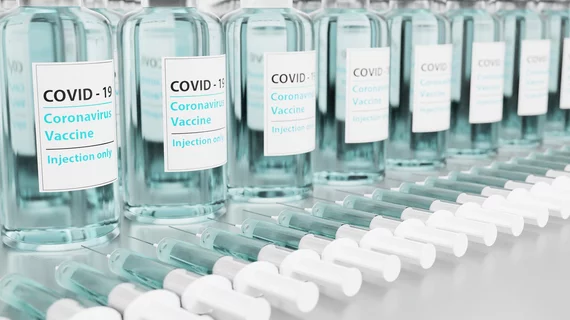Coordination, communication key to avoiding COVID-19 vaccine-related abnormalities on imaging exams
Patients recently vaccinated against COVID-19 may have PET/CT findings that mimic cancer, putting radiologists in a difficult diagnostic position. Yet many of these cases can be avoided with advanced planning and care coordination.
That’s according to radiologists from the University of Massachusetts Medical School, who shared their experience managing oncology patients with confounding findings, May 10 in Cancer Treatment Reviews.
Both Moderna and Pfizer-BioNTech list axillary lymphadenopathy as a top side effect. And while many abnormalities resolve at least six weeks after patients’ second dose, research last month showed abnormal uptake may actually last 7-10 weeks following the mRNA-based Pfizer-BioNTech shot.
“These findings will pose a significant challenge for follow-up, especially in cases of high-grade or aggressive malignancies, and those requiring urgent initiation of treatment,” Lacey J. McIntosh, DO, MPH, with UMMS-affiliated Memorial Health Care’s oncology imaging division, and colleagues explained. “Optimal coordination between imaging and vaccination can avoid inconclusive and confusing results leading to treatment delays, unnecessary repeat imaging and sampling, and patient anxiety.”
Providers should look out for a few common challenges, including:
1. A lack of awareness among patients and physicians regarding vaccine-induced false-positives. Simple steps such as selecting the correct injection site and optimal imaging scheduling can avoid confusing results.
2. Vaccines are becoming available to patients around the same time as overdue imaging appointments. Conflicts between doses and exams may not be on the radar for patients or their doctors.
3. Individuals scheduling their own appointments are likely vaccinated at venues not integrated into their health system. In these cases, the oncology team can’t help patients avoid potential imaging conflicts.
The researchers presented three solutions to these problems.
1. Patients undergoing cancer treatment need to be made aware of vaccine-related imaging abnormalities and reassured not to postpone their vaccination. The date and location of shots need to be in patients’ medical records.
2. Avoid FDG PET/CT shortly after vaccination to reduce false-positives, when possible. Those with cancer on a specific side of their body should receive their doses on the opposite side.
3. Share as much patient information with the oncology team and radiologists as possible. Optimizing the electronic medical record to auto-pull vaccine info may be feasible.
McIntosh et al. warned cancers that primarily manifest in the lymph nodes/spleen are particularly at-risk for confusing findings. These include breast, trunk, lung, head and neck, and upper extremity melanoma/sarcoma, among others.
Radiologists, patients, and other physicians should keep these suggestions in mind as vaccines continue to roll out, the authors noted.
“Through close communication and patient education, we believe this will eliminate significant challenges for our oncology patients as we strive to end this pandemic,” they concluded.
You can read more from the authors here.

